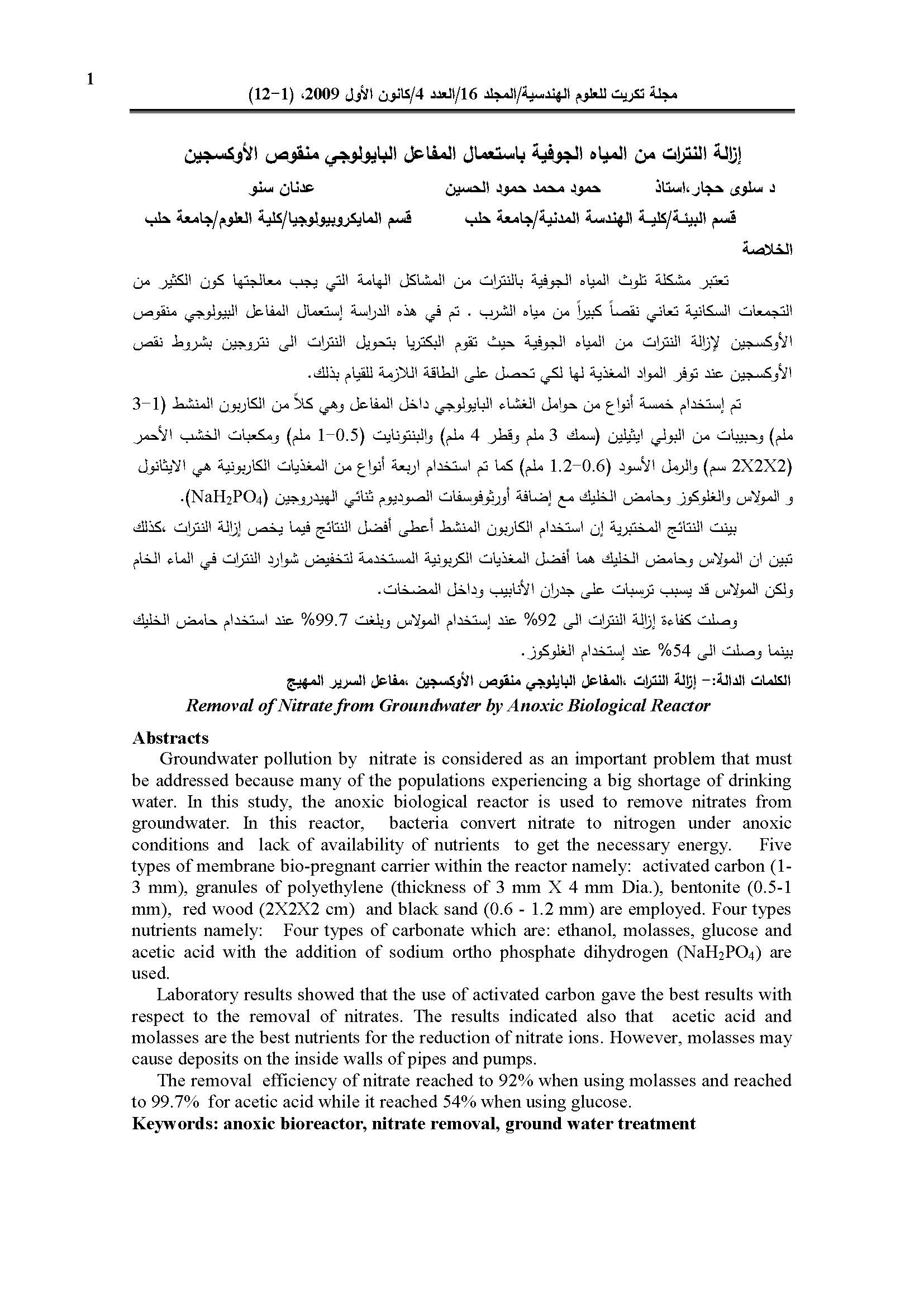Removal of Nitrate from Groundwater by Anoxic Biological Reactor
Main Article Content
Abstract
Groundwater pollution by nitrate is considered as an important problem that must be addressed because many of the populations experiencing a big shortage of drinking water. In this study, the anoxic biological reactor is used to remove nitrates from groundwater. In this reactor, bacteria convert nitrate to nitrogen under anoxic conditions and lack of availability of nutrients to get the necessary energy. Five types of membrane bio-pregnant carrier within the reactor namely: activated carbon (1- 3 mm), granules of polyethylene (thickness of 3 mm X 4 mm Dia.), bentonite (0.5-1 mm), red wood (2X2X2 cm) and black sand (0.6 – 1.2 mm) are employed. Four types nutrients namely: Four types of carbonate which are: ethanol, molasses, glucose and acetic acid with the addition of sodium ortho phosphate dihydrogen (NaH2PO4) are used. Laboratory results showed that the use of activated carbon gave the best results with respect to the removal of nitrates. The results indicated also that acetic acid and molasses are the best nutrients for the reduction of nitrate ions. However, molasses may cause deposits on the inside walls of pipes and pumps. The removal efficiency of nitrate reached to 92% when using molasses and reached to 99.7% for acetic acid while it reached 54% when using glucose.
Metrics
Article Details

This work is licensed under a Creative Commons Attribution 4.0 International License.
THIS IS AN OPEN ACCESS ARTICLE UNDER THE CC BY LICENSE http://creativecommons.org/licenses/by/4.0/
Plaudit
References
سلوى حجار ،2006 “معالجة مياه الشرب ” منشورات جامعة حاب -مديرية الكتب والمطبوعات الجامعية،ص365
M.MC Casland et al ,2005” Nitrate: Health effects in Drinking water”.
Mimesoto department of Agriculture USA 2006 – drinking water protection series ; nitrate contamination – what is the cost.
Degremont 1991, “water treatment handbook” water and the environment p.p.1220.
Techobanoglous G. et al, 1991, “water engineering treatment disposal and reuse”, McGraw – HILL. Inc p.p 432.
Tebbutt T.H.Y., 2006, “Advances in water engineering “Elsevier applied science publishers p.p.180-187 UK.
Clesceri L. S., GREENBERG A. E., EATON A. D., 1998, “Standard Methods for the Examination of Water and Wastewater”, American Public Health Association, American Water Works Association and Water Pollution Control Federation, Washington , 20th edition, 1220 pages.
Postgate J (1998)” Nitrogen fixation”, 3rd ed. Cambridge University Press A. K.
Shelton, D.R. and Ya. A. pachepsky (2005), “Effect of manure on Escherichia coli Attachment to soil”, Beltsville Agricultural Research Center , Water Resource. Res.
IWW ,2007 “CES Consulting Engineers” دراسة ازالة النتروجين في محافظة ريف دمشق (المرحلة الاولى) رقم 10064
Mohammed F. Dahab and Young Woom Lee. ,1992, “Nitrate removal from water supplies using biological dentrification” , J. of WPCE Vol. 60.
Blaszczyk M., Przytocka M., and Mycielski R., 1981, “Denitrification of high concentration of nitrites and nitrate in synthetic medium with different sources of organic carbon”. Act a microbiological polonica, 30, 49-58.
Teran H., 1981, “Toxonomic study and distribution of denitrifying bacteria in lake kizaki “, Microbial Abst. 16 pp139-144. Mohseni Bandpi, D.J. Elliott, 1999, “Denitrification of groundwater using acetic acid as carbon source”, Water science Technology, vol.40 N.2 pp 53-59. DOI: https://doi.org/10.2166/wst.1999.0084
Mark A. Reinsel, Maxwell K Botz, 2004, “(Anoxic Biotreatment Cell)” Patent Storm, United States Patent 5908555.





